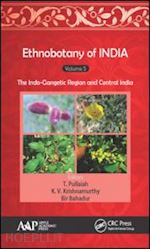T. Pullaiah, PhD, is a former Professor at the Department of Botany at Sri Krishnadevaraya University in Andhra Pradesh, India, where he has taught for more than 35 years. He has held several positions at the university, including Dean, Faculty of Biosciences, Head of the Department of Botany, Head of the Department of Biotechnology, and Member Academic Senate. He was President of the Indian Botanical Society (2014), President of the Indian Association for Angiosperm Taxonomy (2013), and Fellow of the Andhra Pradesh Akademi of Sciences. He was awarded the Panchanan Maheswari Gold Medal, the Dr. G. Panigrahi Memorial Lecture Award of the Indian Botanical Society, the Prof. Y. D. Tyagi Gold Medal of the Indian Association for Angiosperm Taxonomy, and a Best Teacher Award from Government of Andhra Pradesh. Under his guidance 53 students obtained their doctoral degrees. He has authored 45 books, edited 15 books, and published over 300 research papers, including reviews and book chapters. His books include Flora of Eastern Ghats (4 volumes), Flora of Andhra Pradesh (5 volumes), Flora of Telangana (3 volumes), Encyclopedia of World Medicinal Plants (5 volumes), and Encyclopedia of Herbal Antioxidants (3 volumes). He was also a member of Species Survival Commission of International Union for Conservation of Nature (IUCN). K. V. Krishnamurthy, PhD, is a former Professor and Head of Department, Plant Sciences at Bharathidasan University in Tiruchirappalli, India, and is at present an adjunct faculty at the Institute of Ayurveda and Integrative Medicine, Bangalore. He obtained his PhD degree from Madras University, India, and has taught many undergraduate, postgraduate, MPhil, and PhD students. He has over 48 years of teaching and research experience, and his major research areas include plant morphology and morphogenesis, biodiversity, floristic and reproductive ecology, and cytochemistry. He has published more than 170 research papers and 21 books, operated 16 major research projects funded by various agencies, and guided 32 PhD and more than 50 MPhil scholars. His important books include Methods in Cell Wall Cytochemistry (CRC Press, USA), Textbook of Biodiversity (Science Publishers, USA), and From Flower to Fruit (Tata McGraw-Hill, New Delhi). One of his important research projects pertains to a detailed study of the Shevaroys Hills, which form a major hill region in the southern Eastern Ghats, and seven of his PhD scholars have done research work on various aspects of Eastern Ghats. He has won several awards and honors that include the Hira Lal Chakravarthy Award (1984) from the Indian Science Congress; Fulbright Visiting Professorship at the University of Colorado, USA (1993); Best Environmental Scientist Award of Tamil Nadu state (1998); the V. V. Sivarajan Award of the Indian Association for Angiosperm Taxonomy (1998); and the Prof. V. Puri Award from the Indian Botanical Society (2006). He is a fellow of the Linnaean Society, London; National Academy of Sciences, India; and Indian Association of Angiosperm Taxonomy. Bir Bahadur, PhD, was Chairman and Head of the Department, and Dean of the Faculty of Science at Kakatiya University in Warangal, India, and has also taught at Osmania University in Hyderabad, India. During his long academic career, he was honored with the Best Teacher Award by Andhra Pradesh State Government for mentoring thousands of graduates and postgraduate students, including 30 PhDs, most of whom went onto occupy high positions at various universities and research organizations in India and abroad. Dr. Bahadur has been the recipient of many awards and honors, including the Vishwambhar Puri Medal from the Indian Botanical Society for his research contributions in various aspects of plant Sciences. He has published over 200 research papers and reviews and has authored or edited dozen books, including Plant Biology and Biotechnology and Jatropha, Challenges for New Energy Crop, both published in two volumes each by Springer Publishers. Dr. Bahadur is listed as an Eminent Botanist of India, the Bharath Jyoti Award, New Delhi, for his sustained academic and research career at New Delhi and elsewhere. Long active in his field, he has a member of over dozen professional bodies in India and abroad, including Fellow of the Linnean Society (London); Chartered Biologist Fellow of the Institute of Biology (London); Member of the New York Academy of Sciences; and a Royal Society Bursar. He was also honored with an Honorary Fellowship of Birmingham University (UK). Presently he is an Independent Director of Sri Biotech Laboratories India LTD, Hyderabad, India











